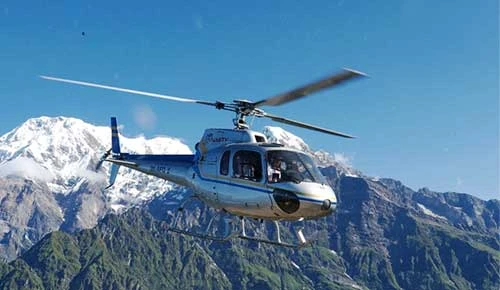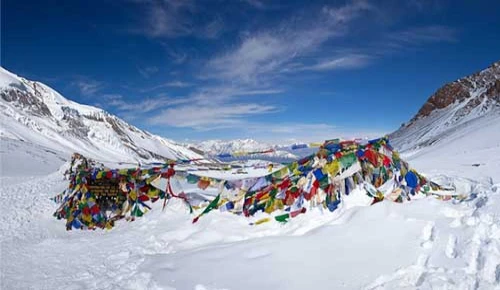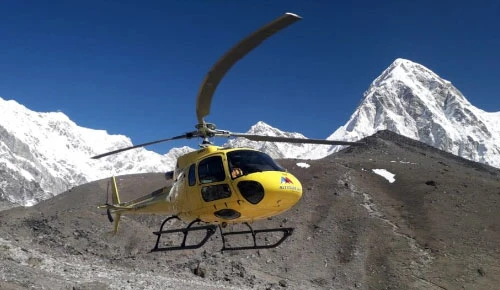Langtang National Park
Langtang National Park is a national protected area that was established in 1976 to conserve the rare flora and fauna of the region. This park is Nepal's first Himalayan national park and the country's fourth protected area.
The park covers an area of 1,710 km2 and is located in the Nuwakot, Rasuwa, and Sindhulpalchowk regions of the central Himalayas. The elevation range of the park lies from 1000m to 7,245 m, and it is the nearest Himalayan park to the capital city of Kathmandu.
The park contains 26 village communities, including Langtang Valley. It is connected to Qomolangma National Nature Preserve in the Tibet Autonomous Region in the north and east. The Bodh Koshi and Trishuli rivers create the eastern and western borders, respectively.
The national park encompasses Gosainkunda and its surrounding lakes, which are famous for their religious, cultural, and natural beauty. In 2007, the Ramsar conservation program declared the Gosainkunda area a wetland of international importance.

Inside the park, the Gosainkunda Lake sits at an elevation of 4,300 meters (14,100 feet). The Dorje Lakpa range at 6,988 m (22,927 ft) divides the park from west-east to south-east. The summit of Langtang Lirung (7,245 m (23,770 ft)) is the highest point in the park.
In 1998, authorities established a protective zone of 420 square kilometers within and surrounding the park. The park is home to a rich biodiversity and serves as a meeting point for the Palearctic and Indo-Malayan regions. Buffer zone management is a collaboration between the park office and the surrounding communities.
Local communities are involved in making decisions regarding the administration of these areas. Furthermore, local communities or the BZ receive 30 to 50% of park revenue for better natural resource management to ensure a continuous supply of resources and community development.
Table of Contents
![Gosaikunda Lake Trekking | Gosainkunda Pass Trek - Only 6 Days]()
Gosaikunda Lake Trekking
Duration: 6 Days
Climate of Langtang National Park
The national park's climate varies according to elevation, with lower elevations having a subtropical climate and higher elevations more typical of alpine and tundra climates.
Subtropical climate (lower altitudes)
- Elevation Range: around 1,000 to 2,000 meters above sea level.
- Climate: The lower regions of Langtang National Park, including the river valleys, have a subtropical climate. Summer temperatures range from 20°C to 30°C (68°F to 86°F), making it hot and humid. Monsoon rains fall from June to September, causing heavy rainfall and occasional flooding. Most winters are mild, with temperatures around 10°C (50°F).
Temperate Climate (Middle Altitudes)
- Elevation Range: around 2,000 to 3,500 meters above sea level.
- Climate: The middle elevations of Langtang National Park have a mild climate. Summers are cooler than in the lower regions, ranging from 10°C to 20°C (50°F to 68°F). Monsoon rains continue to influence the weather throughout the summer. However, winters are colder, with temperatures dropping below freezing, particularly at night.
Alpine and Tundra Climate (Higher Altitudes)
- Altitude Range: Above 3,500 meters above sea level.
- Climate: At higher elevations, Langtang National Park has an alpine and tundra climate. Summers are brief and chilly, with daytime temperatures rarely exceeding 10°C (50°F). The nights are frigid, with temperatures frequently falling below freezing. The amount of rainfall is lower than in lower elevations, and snowfall can occur throughout the year, especially at the highest peaks.
Flora and Fauna
In the southern part of the park, Sal (Shorea robusta) forest is the main type of subtropical vegetation. A hill forest (2000–2600 m) with Chirpine, Rhododendron, and Nepalese alder slowly takes over. There is mostly oak forest in the temperate zone (2600–3000 m), and silver fir, hemlock, and larch old-growth forest in the lower sub-alpine zone (3000–3600 m).
This park and a few places elsewhere are home to the Nepalese larch (Larixnepalensis), the only evergreen conifer in the region. In this park,various types of Rhododendron grow, including R. arboretum, R. barbatum, R. campanulatum, and R. lepidotum (scrubs). These flowers make the land colorful beneath the trees.

Langtang's vast high grasslands provide summer habitat for a variety of wildlife species, including musk deer and Himalayan tahr. It is also famous for various species of wildlife like the red panda, the Himalayan black bear, the snow leopard, the wild dog, the ghoral, the serow, the snow leopard, pika, muntjac, musk deer, the Himalayan tahr, the ghoral, the serow, the rhesus monkey, the langur, and the monkey. In addition, the park is home to 70 butterfly species and 373 species of birds, including the tragopan and impeyan pheasant.
Activities
Langtang National Park, located in Nepal's north-central area, is a popular trekking destination. The Langtang area is famous for having a wide range of plants and animals. The National Park includes Gosainkunda and its surrounding lakes, which are renowned for their religious, cultural, and natural splendor.
Trekking is the main activity of Langtang National Park, bringing visitors from all over the world. The park offers a variety of trekking paths suitable for all levels of experience, from strolls to difficult high-altitude treks. One of the most famous routes is the Langtang Valley Trek, which passes by beautiful towns, lush forests, and stunning mountain views. The Tamang Heritage Trail and the Gosainkunda Lake Trek are two other well-known treks that offer different cultural and natural experiences.

Apart from trekking, the park also offers mountaineering journeys for people who are more skilled in outdoor activities. This park encompasses several peaks in the park that are higher than 6,000 meters. Yala Peak and Naya Kanga are two of them. Climbing these summits demands technical abilities and suitable equipment, but the breathtaking views from the top make the effort worthwhile. Mountaineering in Langtang is an enjoyable way to push your limits and see remote mountain areas.
Whether you want to go trekking or mountain climbing, the Langtang trekking route is well-facilitated for tourists to stay. There are several locally owned hotels and lodges, steakhouses, and campgrounds. These places are open all year, except for the peak winter months. The hiking route gives you an unparalleled opportunity to experience the Tamang people, music, dance, and food. Learning about the Tamang religion, buildings, and crafts gives visitors a better understanding of how their lives are deeply connected to nature.
Popular Trekking Routes
Langtang is mostly known for its beautiful scenery and rare animals, plants, and birds. Trekking is often done there, and the untouched settlement is a great place to stay. In the Langtang area, there are three important trekking routes. Some of the most famous trekking routes in Langtang are the Langtang Valley Trek, the Helambu Trek, and the Gosainkunda Lake Trek. Other treks, like the Panch Pokhari Trek, are also very popular. The area around Gosaikunda Lake includes the southern part of Helambu and several national parks. Laurebina La Pass (4600 m), one of the most significant passes in this area, connects the Langtang and Helambu regions.

There are many hiking trails in this area that offer moderate-to-tough hikes that last anywhere from three days to three weeks. People who live in human settlement areas make it easy to find a place to stay by offering homestays, local motels, and small hotels. However, camping is also possible in some places in Langtang. However, camping may not be allowed in the national park area.
Trekkers must self-support in the eastern parts of Helambu, the Langtang glacier, and the upper Langtang valley from Kyanjin, as well as Ganja La pass (5,120 m) in the Upper Langtang valley, where there is little human settlement and hotel and food options may be limited.
Attractions of Langtang National Park
Langtang National Park encompasses various natural beauties, from rare flora and fauna to the highest Langtang peak. Here are some of the lists of attractions in the national park.
Langtang National Park

Langtang Nationa Park itself is an attraction in the Langtang region. It is located in the center of the Himalayas and borders Tibet, covering an area of 1,710 square kilometers. The park is famous for its diverse ecosystems, which include high mountain peaks, glaciers, alpine grasslands, and subtropical forests. It also has several endangered species, such as the red panda, snow leopard, and Himalayan black bear.
Langtang Valley Trek

The Langtang Valley Trek is one of Nepal's most popular trekking routes, providing breathtaking views of the Himalayas as well as unique cultural experiences. The trek takes you through traditional Tamang villages, lush forests, and high alpine meadows, giving you the opportunity to interact with locals and learn about their way of life. The Trek is moderately difficult, with varying terrain and elevation gains. Proper acclimatization is essential for a successful trek.
Rare Flora and Fauna Diversity

Langtang National Park is renowned for its rich flora, which comprises medicinal herbs, rhododendrons, oak, and maple, among others. The park is home to a diverse range of wildlife, including the elusive snow leopard, red panda, Himalayan tahr, musk deer, and several bird species.
Kyanjin Gompa

The Kyanjin Gompa is a sacred Tibetan Buddhist monastery in the Langtang Valley. It serves as a spiritual center for both locals and trekkers. The monastery has traditional Tibetan architecture, including colorful prayer flags fluttering in the wind and intricate murals depicting Buddhist teachings.
Gosaikunda Lake

Gosaikunda Lake is a glacial lake at an elevation of 4,380 meters above sea level. Hindus and Buddhists consider it a sacred pilgrimage site. The snow-capped peaks and pristine wilderness surrounding Gosaikunda provide breathtaking views as well as opportunities for trekking and photography.
Langtang Lirung and surrounding range

Langtang Lirung, the highest peak in the Langtang Himal range, stands at 7,227 meters. It dominates the landscape, setting a dramatic scene for hikers and climbers. The surrounding mountain range includes several other notable peaks, such as Dorje Lakpa, Gangchenpo, and Langshisha Ri, offering spectacular vistas from various vantage points along the trekking route.
Traditional Tamang villages of the Langtang region

The Tamang ethnic group inhabits the Langtang region, renowned for their rich cultural heritage and warm hospitality. Trekking through traditional Tamang villages gives visitors a glimpse into authentic Nepalese rural life, full of traditional houses, terraced fields, and communal gathering places.
Breathtaking views of Nature
The Langtang Valley has breathtaking natural beauty, with panoramic views of towering snow-capped peaks, lush forests, and charming mountain villages. Throughout the trek, hikers will have numerous opportunities to photograph breathtaking landscapes, colorful flora, and unique cultural scenes. Whether trekking through rhododendron forests ablaze with color in the spring or witnessing sunrise over the Himalayas, the Langtang region provides unforgettable experiences for both nature lovers and adventurers.
Best Season to Visit
Langtang National Park offers a mesmerizing experience to nature lovers and adventurers alike. The best time to visit this pristine wilderness depends on your preferences and interests.
Spring (March to May)

Spring is surely the best time to visit Langtang National Park. The park is vibrant with color during this season, when the rhododendrons bloom and cover the hillsides in shades of red, pink, and white. The weather is mild and pleasant, making it perfect for trekking and discovering the region's diverse flora and fauna. In addition, the trails are less crowded than during the peak autumn season.
Autumn (September to November)

Autumn is another great time to visit Langtang National Park. The skies are clear, providing breathtaking views of the surrounding Himalayan peaks, such as Langtang Lirung, Dorje Lakpa, and Ganesh Himal. The weather is stable, with mild temperatures and little rain, making it ideal for hiking and other outdoor activities. In addition, fall is harvest time, which is a great time to experience the local festivals and culture.
Winter (December to February)

Although Langtang National Park experiences colder temperatures and occasional snowfall, it provides a unique experience for those seeking solitude and tranquility. The snow-capped mountains and frozen landscapes create a magical atmosphere, while the clear skies allow for excellent panoramic views. While some higher-altitude trails may be inaccessible due to snow, lower-altitude treks, such as the Langtang Valley trek, are still possible with the right gear and preparation.
Monsoon (June to August)
The monsoon season in Langtang National Park is characterized by heavy rainfall, which can result in landslides and make trekking trails hazardous. The thick clouds make it hard to see the mountains, and the humidity makes leeches and mosquitoes more likely to bite. Therefore, it is generally advisable to avoid visiting the park during this time, as the weather conditions may affect outdoor activities and travel arrangements.
Health and Medical Information
Altitude sickness is a major concern during the visit to Langtang, especially for trekking and hiking, as the highest point of the trek is over 4600 m. So it's important to acclimate properly and ascend slowly to avoid any altitude-related problems. It's also recommended to rest for a day or two at lower altitudes so that the body can adjust before heading towards higher elevations.
Some vaccinations are also important considerations while travelling to Nepal, including hepatitis A, hepatitis B, typhoid, and rabies. Travellers are recommended to take the vaccination before travelling to Nepal.

Sometimes, waterborne and foodborne illnesses can also be a concern in Nepal. It is advisable to drink boiled or bottled water and consume well-cooked food. Carry mosquito repellent to avoid mosquito bites.
Medical facilities along the trekking route have limited resources and capacity. It is critical to have travel health insurance that includes medical care and emergency evacuation. Additionally, you should bring a fully stocked first-aid kit and any necessary prescription medication for the hike.
Overall, with proper planning and precautions, your trip to Langtang Valley can be safe and enjoyable. Consult your doctor before travelling and follow their recommendations for vaccinations and other health concerns. As you take care of your health, don't forget to enjoy the breathtaking mountain scenery.
Things to Know
- Proper acclimatization is necessary for any type of trek. If you plan to travel to higher altitudes, you should be aware of the possibility of high-altitude sickness.
- Always be aware of wildlife; do not harm them and take caution. `
- It is prohibited to start a fire in an open area within the National Park.
- Let's move toward sustainability in an increasingly polluted world. Avoid using plastic and carry out what you bring in.
- The water from taps and glacier water may contain impurities, including minerals. Always use ozonated water or purify your own water.
- Obtain a permit every time you want to enter a park.
- Avoid taking a stroll in the National Park region at dawn and dusk.
- Lastly, show respect for the local religious sites and cultural values.
- It can be extremely dangerous to hike in this area alone, so either go in groups or with a guide.
- Filming and documentary costs of USD 1500 (for international participants), Rs. 15000 (SAARC Nationals) and Rs. 10000 (Nepali) should be paid at DNPWC. Participants should pay an additional 25% when using a drone for documentaries and filming.








